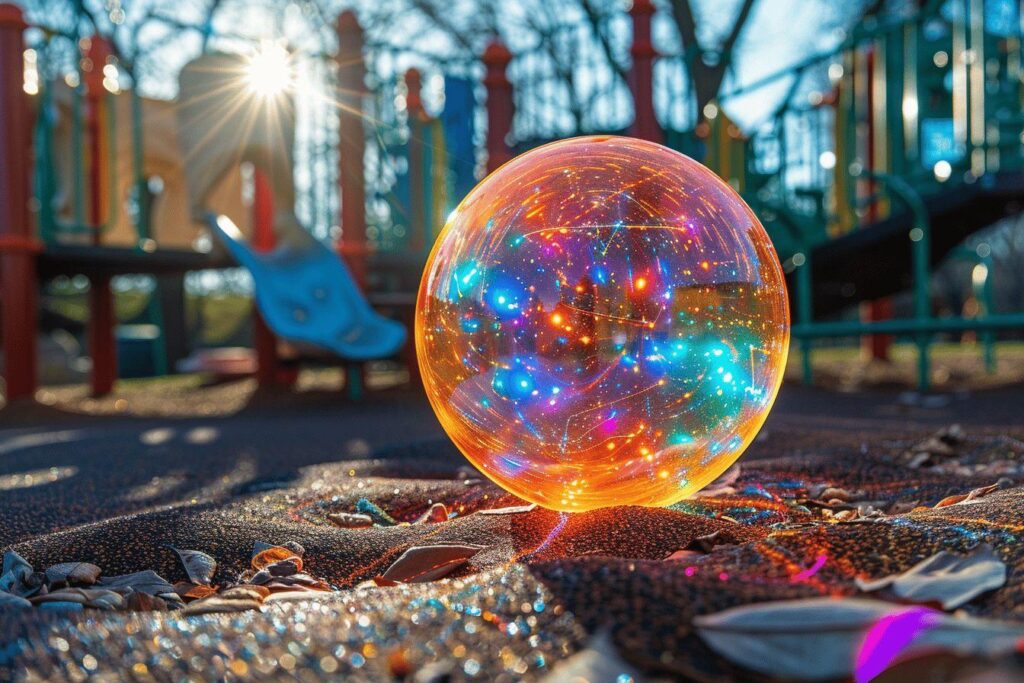Bright bouncing balls enchant young and old with their ability to jump and light up space. These colorful, festive toys provide hours of entertainment while stimulating children’s motor development. Let’s take a look at the features and benefits of these popular bouncing balls, as well as the criteria to consider when choosing the ideal model for your family.
Features and benefits of bouncing balls
Bouncing balls are distinguished by their innovative design and multiple functionalities. Made from durable materials such as phthalate-free recycled PVC or silicone, these balls combine strength and safety for children. Their textured surface and varied patterns, from confetti to multicolored designs, stimulate the senses and capture the attention of little explorers.
One of the main assets of these balls is their exceptional bounce capacity. With a bounce rate of up to 90%, they rival high-end silicone balls. This feature makes them particularly suitable for outdoor play, children’s parties and play activities at home.
Here are some of the key benefits of bouncing balls:
- Development of motor coordination and balance
- Sensory stimulation thanks to bright colors and varied textures
- Production of fun sounds (chirps, chirps) when bouncing
- Adaptability to different skill levels thanks to various sizes
- Potential for use in bouncing juggling for the most skilful
These bouncing balls are generally recommended for children aged 2 to 6, although some models are suitable for children as young as 10 months. Their versatility makes them valuable tools for the psychomotor development of young children.
Choosing the right bouncing ball
To select the perfect bouncing ball, several criteria come into play. The size of the ball is a crucial factor, as it determines the ease of handling and the level of challenge for the child. Standard dimensions are as follows:
| Size | Level | Recommended age |
|---|---|---|
| 65 mm | Beginner | 2-3 years |
| 70 mm | Intermediate | 3-4 years |
| 75 mm | Advanced | 5-6 years |
The choice of materials is also important. Recycled PVC balls offer excellent value for money, while silicone balls, although more expensive, offer superior durability. It’s essential to check that the materials used are phthalate-free and comply with current safety standards.
Play features, such as light or sound effects, can greatly influence a ball’s appeal to children. Some models light up on contact with the ground, creating an interesting spectacle when bouncing. Others emit cheerful sounds, adding an auditory dimension to the play experience.
Finally, price is a factor to consider. PVC bouncing balls are generally 3 to 6 times cheaper than their silicone counterparts, with prices ranging from 25 to 60 euros. It’s important to find the right balance between quality, functionality and budget to make the best possible choice.

Activities and games with jumping balls
Bouncing balls offer vast potential for fun and educational activities. They can be used for throwing and catching games, stimulating hand-eye coordination and reflexes. Children also love to bounce them against walls or on the floor, creating personalized courses and challenges.
For younger children, these balls are perfect for sensory exploration. The different textures, colors and sounds emitted by the balls encourage curiosity and tactile discovery. Parents can organize color sorting or bounce counting games to add an educational dimension to the fun.
Here are a few ideas for activities with bouncing balls:
- Obstacle courses where the child has to bounce the ball while moving around
- Precision games to land the ball in circles drawn on the ground.
- Competition for the highest bounce, encouraging motor skills and a competitive spirit.
- Create rhythmic choreographies by synchronizing bounces with music.
- Role-playing games where the ball becomes a character with its own story
For adults and older children alike, bouncing juggling offers a stimulating challenge. This discipline combines classical juggling techniques with the unique properties of bouncing balls, creating impressive visual spectacles and developing dexterity.
Care and durability of bouncing balls
To get the most out of your bouncing balls over the long term, regular maintenance is essential. Most models can be cleaned simply with warm water and mild soap. It is important to dry the ball completely after cleaning to avoid any moisture build-up that could affect its performance.
Some bouncing balls have the peculiarity of swelling over time. This phenomenon, far from being a defect, can actually extend the life of the toy by adapting to the child’s growth. For models delivered deflated, it’s crucial to follow the manufacturer’s inflation instructions carefully.
The durability of bouncing balls depends largely on their use and maintenance. Silicone models, although more expensive to buy, generally offer superior resistance to wear and repeated impacts. Recycled PVC balls, on the other hand, represent a more economical option, while remaining robust enough for everyday use.
By taking good care of your bouncing balls and using them appropriately, you’ll be able to enjoy long hours of play and learning. These versatile toys will continue to bring joy and stimulation to the whole family, while contributing to the harmonious development of children.

